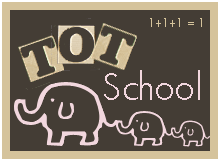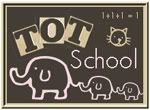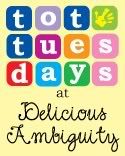B is currently 30 months old.
(Note: This post is the third in a series on adapting games

Another game we've had fun with lately is Sherlock Deluxe. Although the recommended minimum age is 5 years, I heartily agree with the claim on the back of the box that calls this "A Memory Game For the Whole Family!" J and I enjoy playing as much as our children, and it is easily adaptable for younger players as well.

The game comes with a large deck of sturdy, easy-to-handle picture cards attractively illustrated with common animals and objects such as a balloon, a key, a duck, a drum, a sun, and a lightbulb.

Also included is a pawn in the shape of Sherlock the dog, the game's mascot.

When played according to the game instructions, the deck is shuffled, then eight picture cards are arranged in a circle as in the photo above. The players agree on a reasonable amount of time to memorize which card is where, then they are all turned face-down.

The person to the right of the current player places the pawn in front of any card. The current player then attempts to name the object or animal on the card. If the card is guessed correctly, the player moves the pawn the number of spaces and in the direction shown on the card. The player's turn continues until the pawn lands on a face-up card, which the player then wins. (The above photo shows a turn where the player correctly named the lightbulb, then moved around the circle and correctly named the duck, and is now ready to guess another card.) If a player guesses incorrectly, all the cards are turned face-down and the next player takes a turn.
This is a fun alternative to matching-type memory games, and the number of cards can be adjusted up or down to increase or decrease the level of challenge. One time, when we were all playing, I asked everyone to tell us their strategy for memorizing the cards. It was fascinating (and a great learning experience) to see that we each had a different method of accomplishing the same thing!

Here is the way B and I like to play together--with just four cards at a time. The game usually holds his interest for at least two turns each (sometimes longer), and I have been amazed at his ability to remember the pictures. His favorite thing, though, is moving the pawn, which is great for counting practice.
When we first lay out the cards, I verbalize my own strategy of memorizing them--relating them to a person, object, or location in the room. For example, I'll say, "The duck is sitting on Mom's head, B is playing with the yo-yo, the light bulb is hanging on the fireplace, and the chair is by the bookcase." B has really picked up on this, and will repeat these phrases when guessing the cards on his turn.
In addition to playing the game as intended, we have used (or plan to use) the cards in the following ways:
- B loves to just look through the picture cards and talk about the animals and objects he sees, asking lots of questions.
- One day, B decided to sort the cards according to the numbers on them.
- N and K used these for a story game they devised all on their own, where each player draws a certain number of cards from the deck, then has to write a cohesive story containing all of the objects. They turned out so fun!
- The cards could be sorted into different categories, based on color, purpose, usual location, etc. I would like to try this type of activity with B this week.
To see what other tots are doing for fun and learning, be sure to check out Carisa's blog.











2 comments:
What a great way to adapt the game!
Thanks!
Post a Comment